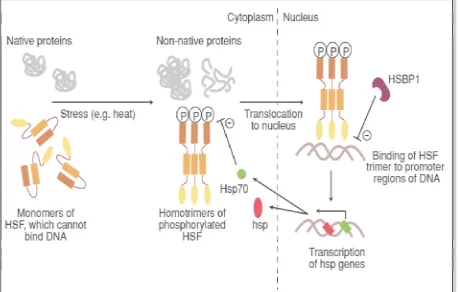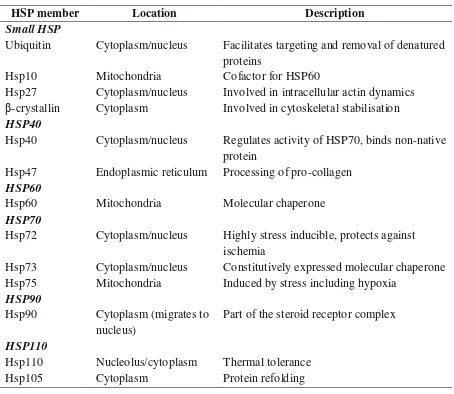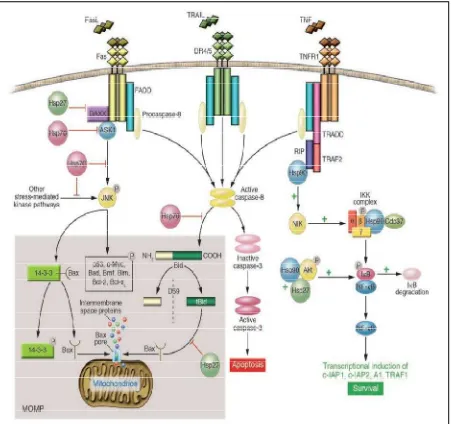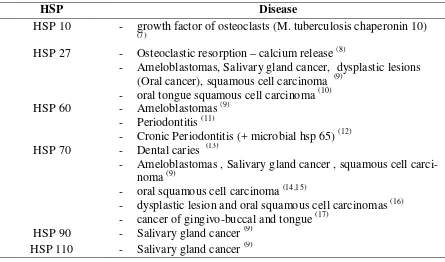Correspondence: Muhammad Nurul Amin, Biomedical/Orthodontic Department, Dentistry Faculty of Jember University, e-mail: m_nurul_amin.fkg@unej.ac.id
IDJ, Volume 1, No. 2, Tahun 2012 81
The Prospect Of Heat Shock Protein (Hsp) As Biomarker Of Oral Disease
Prospek Heat Shock Protein (Hsp) Sebagai Biomarker Penyakit Gigi Dan Mulut
Muhammad Nurul Amin1
1
Biomedical/Orthodontic Department, Dentistry Faculty of Jember University
Abstract
The prevalence of oral diseases is increasing and caused by many factors. It can be caused by environmental, genetic, malignancy or side effects of dental treatment. The research detect these disease has been done, but still not getting satisfactory results. Heat shock proteins (HSP) are intracellular proteins that mediate the cytoprotective function and other essential functions. This protein is expressed and synthesized under conditions of stress/harmful or nonstress. The oral disease is a form of adverse conditions, and the course will also trigger HSP expression.
Keyword: Heat shock protein (HSP), biomarker, oral disease
Abstract
Prevalensi penyakit gigi dan mulut semakin meningkat dan disebabkan oleh banyak factor. Hal tresebut dapat disebabkan lingkungan, genetic, keganasan ataupun efek samping perawa-tan gigi. Penelitian untuk mendeteksi penyakit-penyakit tersebut sudah banyak dilakukan, te-tapi masih belum memberikan hasil yang memuaskan. Heat shock proteins (HSP) adalah pro-tein intraselular yang memediasi fungsi sitoprotektif dan fungsi penting lainnya. Propro-tein ini diekspresikan dan disintesis dibawah kondisi stress/berbahaya ataupun nonstress. Sedangkan penyakit gigi dan mulut merupakan salah satu bentuk kondisi yang merugikan dan tentu saja akan memicu ekspresi HSP.
Kata Kunci: Heat shock protein (HSP), biomarker, Penyakit gigi dan mulut
Introduction
Heat shock proteins (Hsps) are a family of highly homologous chaperone proteins that are induced in response to environmen-tal, physical and chemical stressesand that limit the consequences of damage and facili-tate cellular recovery. 1,2,3 The stresses that can trigger this response vary widely, and include heat or cold, osmotic imbalance, tox-ins, heavy metals and pathophysiological signals such as cytokines and eicosanoids. The cell-stress response is an evolutionarily
ancient, ubiquitous and essential mechanism for cell survival. 2,3
70 IDJ, Volume 1, No. 2, Tahun 2012
Exposure of cells to potentially damag-ing stresses such as UV or nutrient with-drawal induces signals able to mediate cell death, or alternatively, survival pathways that allow cells to tolerate and/or to recover from the damage imposed. This paradoxical acti-vation of both pro and antiapoptotic events in response to the same stimulus ensures that neither aberrant cellular survival nor inap-propriate cell death arises and, in doing so, averts the onset and persistence of the patho-logical state. 5
The Activation of Heat shock Gen
[image:2.595.85.544.317.609.2]Heat shock factor (HSF) is present in the cytoplasm as a latent monomeric molecule that is unable to bind to DNA. Under stressful conditions, the flux of non native proteins (which are non-functional, prone to aggregation, protease-sensitive, and bind to chaperones) leads to phosphorylation (P) and trimerisation of HSF. The trimmers translocate to the nucleus, bind the promoter regions of heat shock protein (hsp) genes and mediate hsp gene transcription. The activity of HSF trimers is downregulated by hsps (e.g. Hsp 70) and the heat shock binding protein 1 (HSBP1) that is found in the nucleus. 6
Figure 1. Regulation of Transcription of heat shock protein genes by heat shock factor. 6
The Family of Heat Shock Protein
The primary function of the HSPs ap-pears to serve as molecular chaperones in which they recognize and bind to nascent po-lypeptide chains and partially folded inter-mediates of proteins, preventing their aggre-gation and misfolding, or as chaperonins that
104 IDJ, Volume 1, No. 2, Tahun 2012
HSPs include the small HSPs, HSP40, 60, 70, 90, and 110 families. In mammalian spe-cies, the HSP60 (chaperonin) family consists
[image:3.595.85.539.180.574.2]of mitochondrial Hsp60 (mt-Hsp60) and cy-tosolic Hsp60 (T-complex polypeptide-1).7
Table 1. Key members of the heat shock protein family in humans (2,4,6)
The Expression and potential therapeutic Application of heat shock protein
The network of heat shock or stress pro-teins represents an emerging paradigm for the coordinated, multistep regulation of apoptotic signaling events to provide protec-tion from and to facilitate cellular recovery after exposure to damaging stimuli. Heat shock proteins (Hsps) constitute a highly conserved and functionally interactive
net-work of chaperone proteins, some of which are constitutively expressed and others of which are rapidly induced in response to a variety of chemical, environmental, and phy-siological stresses. Their collective ability to disaggregate, refold, and renature misfolded proteins offsets the otherwise fatal conse-quences of damaging stimuli. This protective function of Hsps has been suggested to re-flect their ability to suppress several forms of cell death, including apoptosis.5,6
HSP member Location Description
Small HSP
Ubiquitin Cytoplasm/nucleus Facilitates targeting and removal of denatured proteins
Hsp10 Mitochondria Cofactor for HSP60
Hsp27 Cytoplasm/nucleus Involved in intracellular actin dynamics
β-crystallin Cytoplasm Involved in cytoskeletal stabilisation
HSP40
Hsp40 Cytoplasm/nucleus Regulates activity of HSP70, binds non-native protein
Hsp47 Endoplasmic reticulum Processing of pro-collagen
HSP60
Hsp60 Mitochondria Molecular chaperone
HSP70
Hsp72 Cytoplasm/nucleus Highly stress inducible, protects against ischemia
Hsp73 Cytoplasm/nucleus Constitutively expressed molecular chaperone Hsp75 Mitochondria Induced by stress including hypoxia
HSP90
Hsp90 Cytoplasm (migrates to nucleus)
Part of the steroid receptor complex
HSP110
Hsp110 Nucleolus/cytoplasm Thermal tolerance
74 IDJ, Volume 1, No. 2, Tahun 2012
Figure 2. Regulation of the extrinsic pathway by Hsps.5
Hsps regulate at multiple points within the signaling pathways activated by ligation of a cell surface death receptor by the appro-priate ligand. These include the maintenance of prosurvival signals generated via TNF-mediated activation of NF-κB and suppre s-sion of proapoptotic signaling events, e.g., JNK activity and Bid cleavage. Integration of the extrinsic and intrinsic pathways is me-diated via the caspase-8–meme-diated cleavage and activation of Bid as well as activation of JNK, which can impact on numerous mole-cules that regulate mitochondrial integrity (shown in the shaded area). 5
Hsps regulate several aspects of the in-trinsic apoptotic pathway. These include both direct mediators — e.g., Bax — and indirect regulators — e.g., Akt — of mitochondrial membrane permeabilization to prevent MOMP as well as events downstream of mi-tochondrial disruption to regulate apopto-some assembly. Caspase-independent cell death may also be affected via Hsp-mediated suppression of AIF activity and inhibition of lysosome permeabilization and cathepsin re-lease.5
IDJ, Volume 1, No. 2, Tahun 2012 73
Table 2. Evidence for the involvement of HSP/Chaperonin in Oral disease
HSP Disease
HSP 10 - growth factor of osteoclasts (M. tuberculosis chaperonin 10)
(7)
HSP 27 - Osteoclastic resorption – calcium release (8)
- Ameloblastomas, Salivary gland cancer, dysplastic lesions (Oral cancer), squamous cell carcinoma (9)
- oral tongue squamous cell carcinoma (10)
HSP 60 - Ameloblastomas (9)
- Periodontitis (11)
- Cronic Periodontitis (+ microbial hsp 65) (12) HSP 70 - Dental caries (13)
- Ameloblastomas , Salivary gland cancer , squamous cell carci-noma (9)
- oral squamous cell carcinoma (14,15)
- dysplastic lesion and oral squamous cell carcinomas (16) - cancer of gingivo-buccal and tongue (17)
HSP 90 - Salivary gland cancer (9) HSP 110 - Salivary gland cancer (9)
Conclusion
HSP may be a candidate as an oral dis-ease biomarker and further research is needed to prove it again
References
1. Helen M. Beere. Journal of Cell Science
117 (13) 2641-2651 Published by The Company of Biologists 2004
2. Ranford J., Anthony R.M. Coates and Brian Henderson. Chaperonins are cell-signalling proteins: the unfolding biolo-gy of molecular chaperones. expert re-views in molecular medicine 15 Septem-ber 2000 ISSN 1462-3994 ©2000 Cam-bridge University Press. http://www-ermm. cbcu.cam.ac.uk
3. Sørensen, J. G., Torsten Nygaard Kris-tensen and Volker Loeschcke. The evo-lutionary and ecological role of heat shock proteins. Ecology Letters, (2003)
6: 1025–1037
4. Min-Fu Tsan and Baochong Gao. Cyto-kine function of heat shock proteins. Am J Physiol Cell Physiol 286: C739–C744, 2004;)
5. Beere, H. M. Death versus survival: Functional interaction between the apop-totic and stress-inducible heat shock pro-tein pathways. J. Clin. Invest. 115:2633– 2639 (2005)
6. Pockley, A. G., Heat shock proteins in health and disease: therapeutic targets or therapeutic agents? Expert Reviews in Molecular Medicine / 3 / pp 1 - 21 7. Sørensen, J. G., Torsten Nygaard
Kris-tensen and Volker Loeschcke. The evo-lutionary and ecological role of heat shock proteins. Ecology Letters, (2003)
6: 1025–1037
8. Gaston, J. S. H. Heat shock proteins and innate immunity Clin Exp Immunol
2002; 127:1–3
9. Ciocca, D. R and Stuart K. Calderwood. Heat shock proteins in cancer: diagnos-tic, prognosdiagnos-tic, predictive, and treatment implications. Cell Stress & Chaperones
(2005) 10 (2), 86–103
IDJ, Volume 1, No. 2, Tahun 2012 107
11. Gregory J. Seymour, Pauline J. Ford, Erica Gemmell, Kazuhisa Yamazaki. In-fection or Inflammation: The Link Be-tween Periodontal Disease and Systemic Disea INSIDE DENTISTRY VOL. 2 (SPECIAL ISSUE 1)
12. Hasan A., D Sadoh, R Palmer, M Foo, M Marber,* and T Lehner.The immune res-ponses to human and microbial heat shock proteins in periodontal disease with and without coronary heart disease.
Clin Exp Immunol. 2005 December; 142(3): 585–594.
13. Kaur R., Hardeep Kataria, Sushil Kumar, and Gurcharan Kaur. Caries Experience among Females aged 16–21 in Punjab, India and its Relationship with Lifestyle and Salivary HSP70 Levels. Eur J Dent.
2010 July; 4(3): 308–313
14. Markopoulos A. K., Eleni Deligianni, Demetrios Z. Antoniades. HSP70 in oral squamous cell carcinoma Heat Shock Protein 70 Membrane Expression in Oral
Cancer: A Possible New Target in Anti-neoplastic Therapy? Chemotherapy
2009;55:211-214
15. Tavassol F., Oliver F Starke, Horst Ko-kemüller, Gerd Wegener, Corinna CM Müller-Tavassol, Nils-Claudius Gellrich, André Eckardt Prognostic significance of heat shock protein 70 (HSP70) in pa-tients with oral cancer. Head & Neck Oncology 2011, 3:10
16. Kaur J., A Srivastava, R Ralhan. Expres-sion of 70-kDa heat shock protein in oral lesions: marker of biological stress or pathogenicity. Oral Oncology Volume
34, Issue 6, November 1998, p: 496-501. 17. Shukla S., Atul Pranay, Anil K. D'Cruz,



